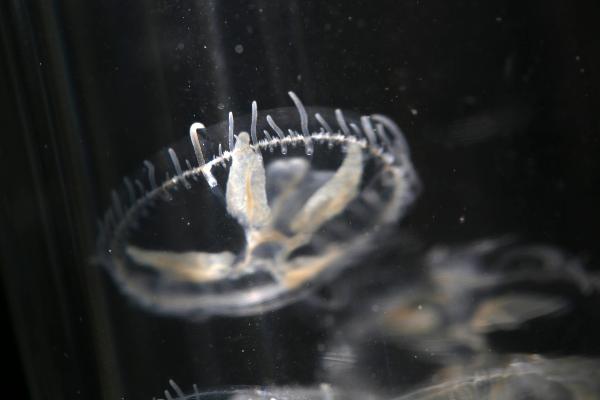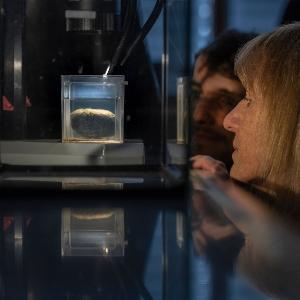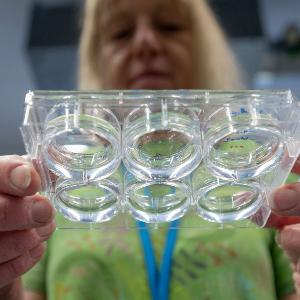Originally from China, it is increasingly being sighted in domestic waters during warm summers: When water temperatures reach about 25 degrees Celsius, the freshwater jellyfish floats as a medusa about two to three centimeters in size. As such, swimmers and divers only encounter the jellyfish, which is completely harmless to humans, in hot years.

© IMAGO / agefotostock / Qin Tingfu / Photoshot
In another, highly inconspicuous stage of life, however, the creature has probably already spread far and wide, suspects Herwig Stibor. The Professor of Aquatic Ecology researches the ecology of Craspedacusta sowerbii – to give the jellyfish its scientific name – and is particularly interested in the polyps, which measure just one to two millimeters, from which the medusae pinch off. In polyp form, the jellyfish spend their lives on the beds of rivers and lakes, where they attach themselves to stones, wood, or plants and grow on them. “Before now, researchers have described the medusae for the most part, because they’re easier to see,” says Stibor. “But that’s actually just a small part of the life cycle of the jellyfish. If we want to understand their invasion dynamics, we need to understand this bottom stage as well, which has almost never been investigated before.”
Indestructible survivalist

Prof. Herwig Stibor | © LMU
In contrast to the medusa with its temperature needs, polyps are extremely resistant. This is what makes the jellyfish such a highly invasive species: “The polyps survive everything by forming resting stages. The resting stages are drought-resistant – you could even freeze them at -250 degrees Celsius or boil them in sulfuric acid and they would survive,” marvels Stibor. As the resting stages latch on to water birds, dragonflies, boats, and even bathing suits, they can spread very effectively from lake to lake. In polyp form, the jellyfish can also spread by means of river currents. “You’ll never see medusae there, because they can’t live in rivers, but after flooding, jellyfish can pop up in places like flood-meadows.” Moreover, polyps can reproduce asexually by cloning themselves. Under certain circumstances, therefore, all you need is the accidental introduction of one individual to colonize an entire lake.
It’s not as if the jellyfish are suddenly colonizing new waterbodies; the polyps were actually there all the time. It’s just that there’s been an exponential growth in the pinching-off of medusae since the 1990s due to rising water temperatures.Herwig Stibor
Consequently, when Stibor, together with research associate Dr. Sabine Giessler and doctoral candidate Stefan Dehos, surveyed Bavarian lakes, he was not surprised when the team discovered polyps in almost every single lake it sampled. “In many lakes, they’re not pinching off any medusae yet – but they’re there.” That being said, the frequency of medusa sightings is on the rise. A citizen science project that encourages ordinary people to report sightings to LMU’s Aquatic Ecology department is partially responsible for this knowledge. Stibor attributes the phenomenon to changes in climate: “It’s not as if the jellyfish are suddenly colonizing new waterbodies; the polyps were actually there all the time. It’s just that there’s been an exponential growth in the pinching-off of medusae since the 1990s due to rising water temperatures.”
From China to Munich Botanical Garden

In polyp form, the jellyfish attach themselves to stones. | © LMU
The jellyfish has been spreading from the Yangtze River in China all over the world for over a hundred years. “In most cases, it showed up initially in botanical gardens, probably through the importing of aquatic plants from China,” notes Stibor. In Germany, the jellyfish was discovered for the first time in 1908 in a lily pond at Munich Botanical Garden. These original specimens are archived in the Bavarian State Collection for Zoology. Using genetic comparisons, Stibor has demonstrated that the descendants of these polyps can still be found in waterbodies. “In the meantime, three to four other lineages have joined them, and presumably there are now two adventive species of freshwater jellyfish, which cannot however be morphologically differentiated,” explains Stibor. “Therefore, the jellyfish were probably introduced multiple times.”
Although the freshwater jellyfish are spreading so successfully, Stibor sees no signs thus far of the immigrants causing ecological problems. In a current study, his team was able to show that the polyps are not competing for food with other small aquatic animals such as water fleas. The medusae, by contrast, compete strongly with juvenile fish for small crustaceans and plankton, which they catch with their tentacles. In Germany, their occurrence is too sporadic and too local to have an effect, says Stibor. But things can play out differently in regions with higher temperatures, such as Israel. “A jellyfish was found in a tributary of the Sea of Galilee in 2016, and because the lake is the only large lake in Israel, there are always concerns that invasive species could affect the local fishing industry, for example.” As part of a research collaboration between LMU and Tel Aviv University, Stibor is systematically investigating whether polyps are present in the tributaries of the Sea of Galilee and in the lake itself, and if so, how far they have already spread.
A puzzle: medusae are overwhelmingly female

Miniature breeding tanks for jellyfish. | © LMU
Back at his laboratory in Martinsried, Stibor keeps hundreds of polyp cultures in miniature breeding tanks, which hold living representatives of all known genetic types. This allows biologists to investigate whether the various lineages differ in certain characteristics – for example, whether some are less sensitive to water pollution than others. Like their wild counterparts, the lab polyps pinch off medusae in the summer. Stibor wants to study this phenomenon to solve a puzzle: As in all jellyfish, the medusae serve the purpose of sexual reproduction. Necessarily, therefore, male and female specimens can occur. But sexual reproduction has never been demonstrated outside of China, and Stibor’s genetic analyses have not found any evidence for it either.
Furthermore, the researchers have found almost exclusively female medusae in the hundreds of lakes they have studied. “The only exceptions are two little Bavarian lakes near Rosenheim and Ingolstadt, where there are males too. Last year, we even managed to find males and females simultaneously. But even there, sexual reproduction did not occur,” says a bemused Stibor. “And in the next lake, which is just 15 meters away, you can analyze until the cows come home and you just will not find a male.” In his mini aquariums, the biologist now wants to investigate which polyps are capable of producing males and get to the bottom of the reproductive barrier. It is also an interesting question from an evolutionary biology perspective, because sexual reproduction facilitates greater genetic diversity and new, potentially better adapted varieties. “Then whole new dynamics would arise.”









